배터리 3사(SK ON, 삼성SDI, LG에너지솔루션)는 지난 3월 15일부터 18일까지 서울 코엑스에서 개최된 인터배터리 전시회에 차세대 배터리와 ESG 전략을 강조하는 모습을 보였다.
SK ON, 세계 최초 니켈 비중 90% 이상 NCM9+ 배터리 전시
삼성SDI 무음극 기술, 고체 전해질 소재리튬 음극재 수명 개선
LG엔솔, 차세대 배터리 포트폴리오 공개…2026년 고분자계 상용화
2023년 배터리 업계의 트렌드는 전고체 배터리를 포함한 차세대 배터리와 친환경으로 보인다.
배터리 3사(SK ON, 삼성SDI, LG에너지솔루션)는 지난 3월 15일부터 18일까지 서울 코엑스에서 개최된 인터배터리 전시회에 차세대 배터리와 ESG 전략을 강조하는 모습을 보였다.
전동화로의 변화 및 이산화탄소 저감 등 지속가능성과 같은 글로벌 트렌드는 기업들이 갖춰야 할 필수적인 요건과 공급망, 주행거리 확대 등 배터리 기업의 시장 선도를 위한 연구개발이 얼마나 이루어졌는지 알 수 있는 전시회였다.
3사 모두 전시한 전고체 배터리는 기존 리튬이온배터리 대비 열 안전성이 뛰어나 폭발이나 화재 가능성이 낮으며 1.5배 수준의 높은 에너지 밀도로 동일 부피 당 더 많은 용량의 배터리 탑재가 가능해 미래 전기차 시장의 게임체인저로 불린다.
또한 RE100 등 친환경성을 강조하고 있는 글로벌 정책에 3사 모두 배터리 재활용 및 재사용 등을 내세우며 미래 지구에 기여하려는 움직임을 보이고 있다.
■ SK ON
SK ON은 액체전해질을 황화물계 고체전해질로 대체하는 차세대 배터리, 고분자 복합계 전고체 배터리와 전고체 배터리를 전시했다.
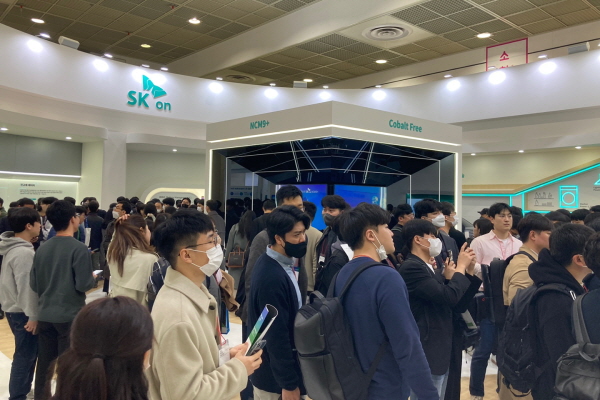
▲인터배터리 SK ON 부스
황화물계는 고체전해질 중 리튬이온 전도도가 높은 장점을 지닌다. 이는 고체전해질-전극활물질 경계면의 부반응을 최소화하여 초기 용량 발현율을 향상시켰고, 에너지 밀도 개선을 위해 니켈 함량 88% 이상의 고용량 복합양극을 개발 중이라 전했다.
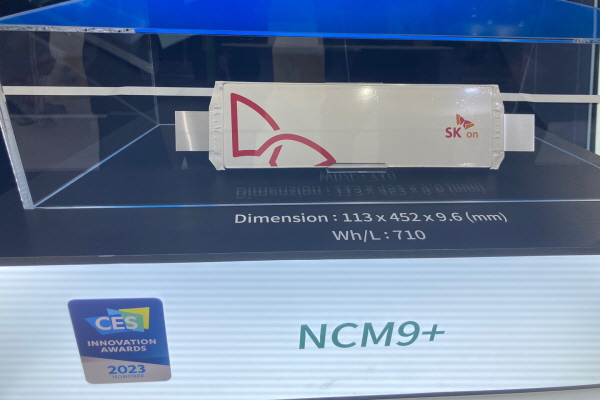
▲SK ON NCM9+ 배터리
SK ON은 또한 CES 2023에서 혁신상을 수상한 NCM9+를 전시했다.
NCM9+는 SK온이 세계 최초로 니켈 비중을 90% 이상으로 높인 NCM9에서 에너지밀도를 추가 개선한 배터리로, 현재 개발을 완료해 양산을 앞두고 있다.
또한 SK ON은 지금까지 공개되지 않았던 다양한 배터리 셀 포트폴리오인 코발트를 완전히 배제한 ‘코발트 프리’(Co-Free) 배터리와 LFP(리튬/철/인산) 배터리, 각형 배터리 등을 처음으로 선보였다.
.jpg)
▲SK ON 코발트 프리 배터리
SK ON은 당초 목표 시점보다 1년 이상 앞당겨 최근 ‘코발트 프리’ 배터리 개발에 성공했다.
NCM(니켈/코발트/망간)으로 대표되는 삼원계 배터리의 경우, 코발트가 없으면 보통 구조적 불안정성 때문에 수명이 저하되는 한계를 갖는다.
SK ON은 독자적인 코팅 및 도핑 기술 등을 통해 이러한 결정적인 단점을 극복했다.
이 기술로 전자의 이동성을 개선해 배터리 출력을 개선해 기존 삼원계 배터리와 유사한 출력을 달성했다.
나아가 삼원계 배터리 소재 중 가장 비싼 코발트 대신 니켈이나 망간을 사용해 가격 경쟁력도 높아질 것으로 전망된다.
이외에도 SK ON은 환경을 위한 제조 및 재활용 기술을 보여주는 영상을 전시했다.
배터리 제조부터 재활용까지 EV 배터리 전 생애주기에 걸친 자원순환 솔루션이다.
배터리 셀을 방전, 파쇄한 뒤에 구리·알루미늄·분리막과 Black Mass 분리한다. 다음 단계로 수소 환원 공정을 통해 블랙 파우더에 존재하는 리튬을 수산화리튬 형태로 회수하는 과정을 거친다.
NCM 페이스트를 황산에 용해하는 침출 과정을 거치고, 니켈·코발트·망간 금속을 추출한 뒤 회수한 금속으로 다시 배터리 셀을 생산하는 자원순환 솔루션이다.
■ 삼성SDI
삼성SDI는 독자적 기술로 개발한 차세대 전고체 배터리를 전시했다.
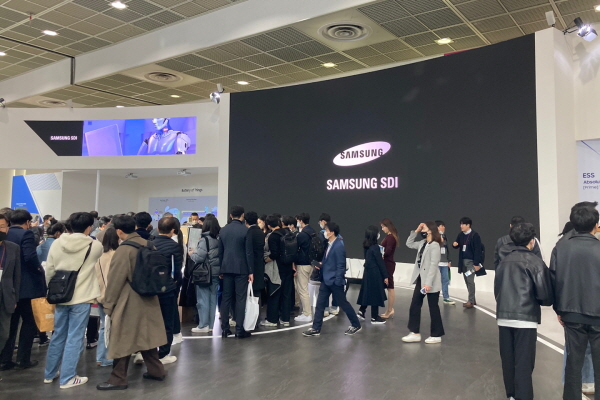
▲인터배터리 삼성SDI 부스
삼성SDI의 전고체 배터리는 독자 조성의 고체 전해질 소재와 리튬 음극재로 수명을 개선한 무음극 기술(Anode-less)이 특징이다.
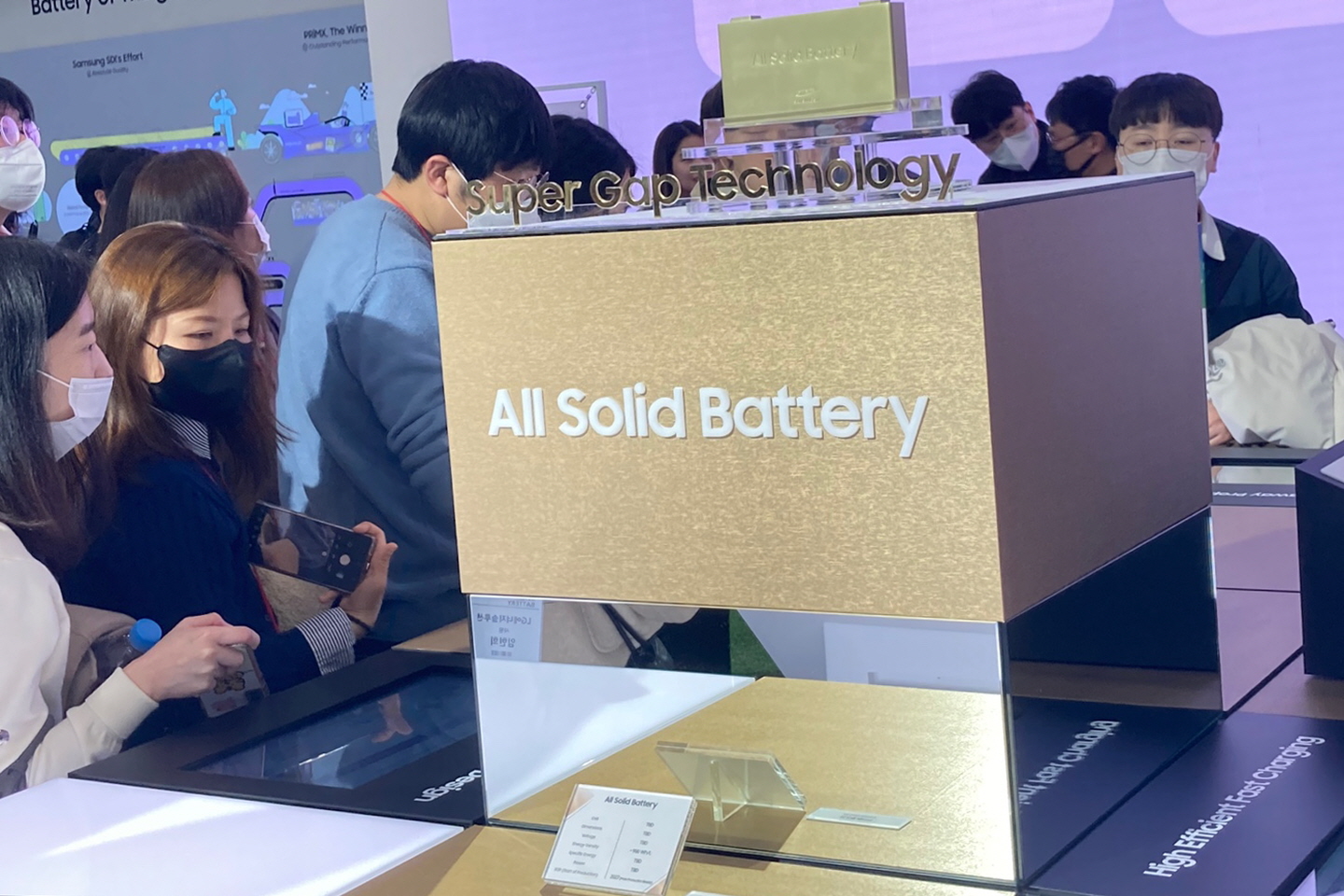
▲삼성SDI 전고체 배터리
또한 기존의 흑연 음극재 대신 실버카본층을 사용해 부피를 획기적으로 줄여 에너지 밀도와 성능을 높였다.
삼성SDI는 2023년 국내 유일한 전고체 배터리 파일럿 라인의 완공을 앞두고 있으며 2027년 최초양산을 준비하고 있다.
삼성SDI는 전고체 배터리 양산의 초석인 ‘S-라인’을 경기도 수원에 약2,000평 규모로 건설 중에 있으며 전고체 배터리를 위한 통합 프로세스를 내재화할 예정이다.
.jpg)
▲삼성SDI S-라인 계획
파일럿 라인을 통해 올해 하반기 시제품 샘플 제작을 시작으로 전고체 배터리 개발 완성도를 높이기 위한 다양한 테스트를 진행할 계획이다.
또한 삼성SDI의 부스 ESS 존에는 안전성을 위한 직분사 시스템과 수랭식 냉각시스템이 탑재된 삼성SDI의 신규 E5S 모듈과 랙을 전시됐으며, IT 존과 Power 존을 통해 스마트폰 및 웨어러블 기기와 AI로봇, 전동공구 등 다양한 제품들을 살펴볼 수 있었다.
xEV 존에서는 BMW '뉴 i7'이 전시됐다.
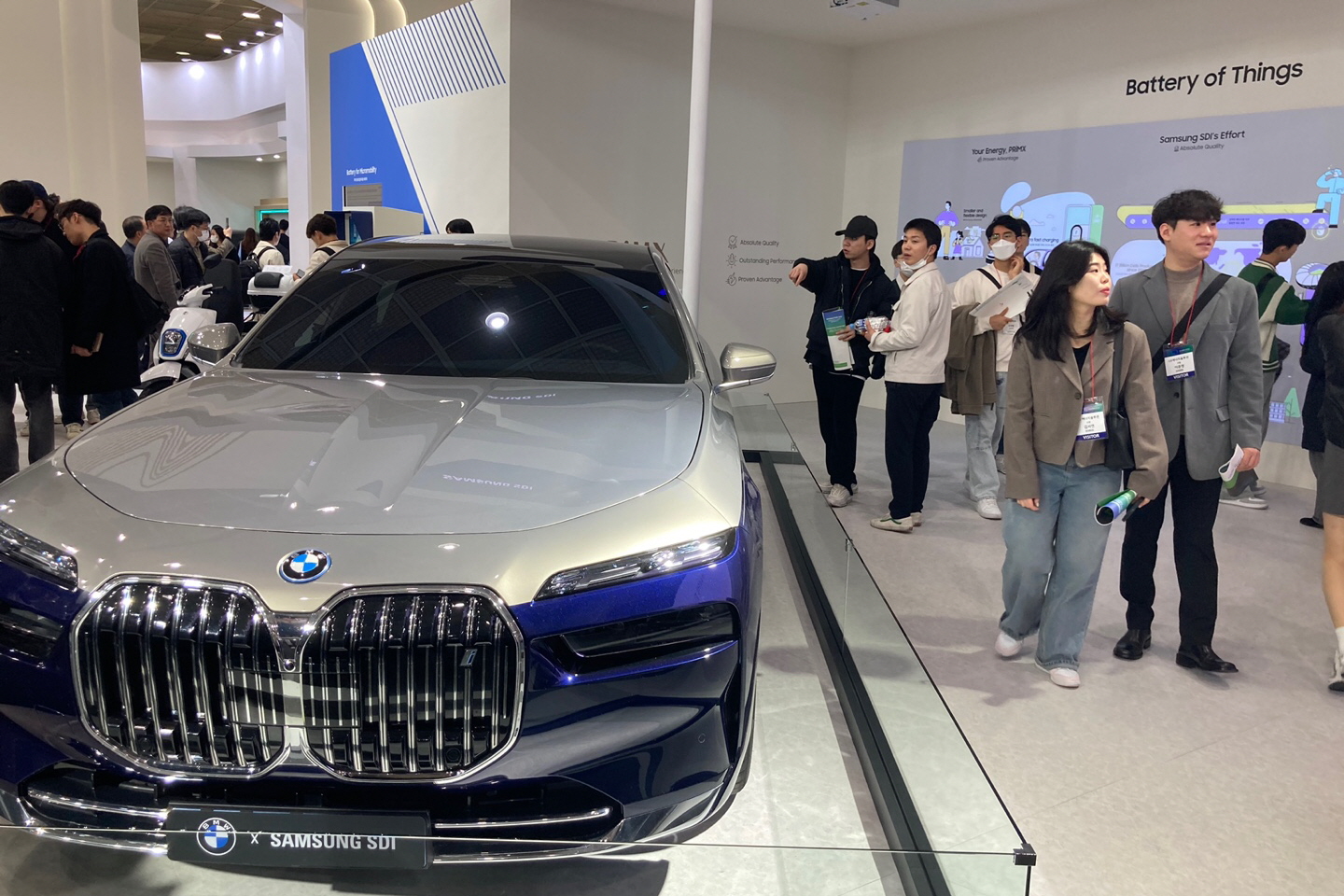 ▲삼성SDI 부스에 전시된 BMW 뉴 i7
▲삼성SDI 부스에 전시된 BMW 뉴 i7
BMW '뉴 i7'은 BMW 최초의 순수전기 플래그십 세단으로 삼성SDI의 P5 배터리(각형)가 탑재된다.
P5 배터리는 니켈 함량 88% 이상의 하이니켈 양극재에 실리콘 음극재 기술이 더해져 고에너지 밀도를 구현했다. BMW의 뉴 i7 외에도 iX, i4 등 최신 전기자동차에 탑재되고 있다.
삼성SDI도 2050년 100% 재생에너지로 만든다는 계획을 전시했다.
2022년 10월 RE100 글로벌 이니셔티브에 가입한 뒤 2025년 해외사업장 100%를 시작으로 2050년 모든 사업장을 전환하겠다는 목표를 공식 선언한 바 있다.
삼성SDI도 지속가능한 배터리 순환 경제를 실현한다는 목표로 배터리로 인한 환경 영향을 최소화하기 위해 재활용과 재사용을 추진하고 있다.
자원 회수 프로세스를 구축하고 회수한 원자재를 배터리 제조에 사용해 순환경제를 실현하고 공급망 다변화에도 기여할 계획이다.
이외에도 삼성SDI 부스에는 마이크로모빌리티용 배터리를 ‘에너지공유’ 교체형 배터리팩으로 제조하는 등 다양한 친환경 전략을 내세우고 있다.
■ LG에너지솔루션
LG에너지솔루션(이하 LG엔솔) 성 향상을 위한 전고체 전지와 고에너지 밀도의 경량 리튬황 전지 등 차세대 전지, 소재·공정 혁신 기술을 전시했다.
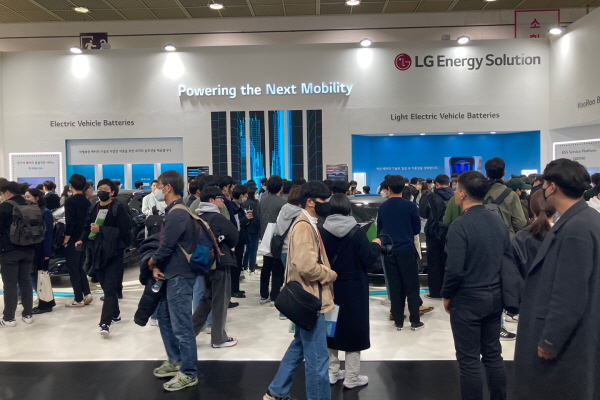 ▲인터배터리 LG에너지솔루션 부스
▲인터배터리 LG에너지솔루션 부스
LG엔솔도 SK ON과 마찬가지로 황화물계 전고체 배터리와 고분자계 배터리를 소개했다.
LG엔솔은 2026년 고분자계 전고체배터리, 2030년 황화물계 전고체배터리를 상용화할 계획이다.
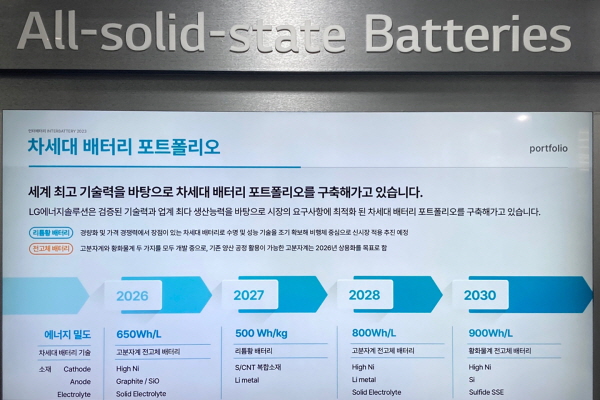 ▲LG에너지솔루션 차세대 배터리 포트폴리오
▲LG에너지솔루션 차세대 배터리 포트폴리오
기존 양산 공정을 활용할 수 있는 고분자계 전고체 배터리는 650Wh/L 밀도로 분리막 없이 고분자 필름만으로 정상 동작이 가능해 안전성이 강화된 차세대 배터리로, 중대형 배터리에 적용될 예정이다.
LG엔솔은 2028년 800Wh/L 에너지 밀도를 가진 고분자계 전고체 배터리를 포트폴리오에 추가하며 배터리 업계를 선도하려는 움직임도 보이고 있다.
황화물계 배터리의 경우 지난해 샌디에이고 대학과의 장수명 전고체 기술을 개발하는 등 다양한 시도를 이어가고 있으며 마이크로 실리콘 음극재를 사용해 용량이 10배 증가하고 500회 충·방전이 가능한 전고체 전지를 개발하고 있다.
이외에도 경량화 및 가격 경쟁력에서 장점을 가진 리튬황 배터리(500Wh/kg)을 2027년 상용화하고 비행체 중심으로 신시장 개척에 나설 계획을 발표했다.
리튬황 배터리는 양극 소재로 황, 음극 소재로 리튬 금속을 사용하는 배터리로 코발트를 사용하지 않아 가격이 저렴한 것이 특징이며, 리튬이온배터리에 비해 황 양극과 리튬 음극의 밀도가 낮고 무게당 용량이 크기 때문에 에너지 밀도가 80%(>500Wh/kg) 이상 높아질 수 있다.
2020년 리튬황 배터리를 탑재한 한국항공우주연구원의 고고도 무인기가 성층권(고도 12~22km)에서의 7시간 포함 총 13시간의 시험 비행에 성공한 바 있다.
또한 LG엔솔은 니켈, 코발트, 망간으로 구성된 NCM 양극재에 알루미늄을 첨가한 사원계 양극재를 소개했다.
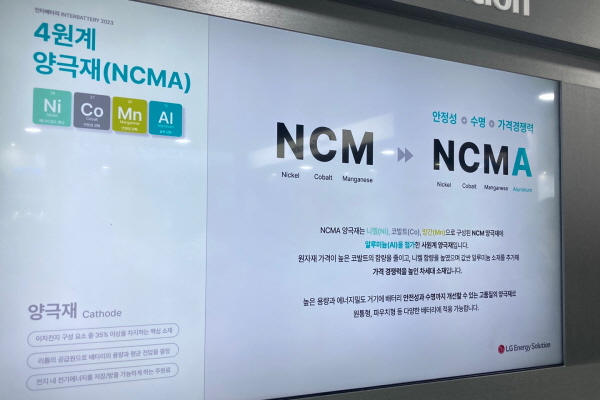 ▲LG에너지솔루션 4원계 양극재 소개
▲LG에너지솔루션 4원계 양극재 소개
원자재 가격이 높은 코발트의 함량을 줄이고, 니켈 함량을 높였으며, 저렴한 알루미늄 소재를 추가해 가격 경쟁력을 높인 차세대 소재다.
안전성과 수명을 개선할 수 있는 양극재로 원통형, 파우치형 등 다양한 배터리에 적용이 가능한 것이 특징이다.
한편 산업통상자원부가 주최한 이차전지산업 전문 전시회인 ‘인터배터리’는 2013년에 처음 개최하여 현재 국내/외 이차전지산업의 미래를 조망하는 비즈니스 플랫폼으로 자리매김했다.
코로나19의 여파가 남아있던 지난해에는 198개사 664 부스 규모였으나, 2023년에는 500개사 1,500 부스로 코로나19를 완전히 씻어 낸 모습이었으며 3일 내내 관람객으로 붐볐다.
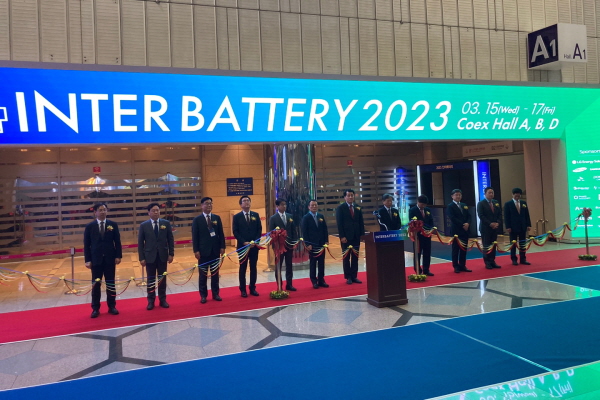 ▲인터배터리 개막식
▲인터배터리 개막식
장영진 산업부 1차관은 15일 개회식에서 “국가전략기술로 지정된 배터리에 대해 투자 세액공제율이 대폭 상향될 수 있도록 추진하고, 업계의 수출·투자를 발목 잡는 규제와 애로는 즉각 해소될 수 있도록 관계부처와 적극 협의해 나갈 것”이라며“이번 행사의 성공을 발판삼아 앞으로 인터배터리 행사가 배터리 업계의 CES로 자리매김할 수 있기를 희망한다”고 전했다.


.jpg)


.jpg)




